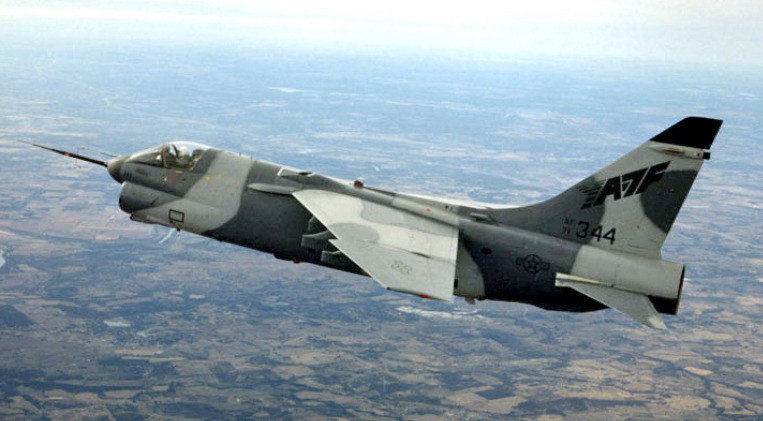Description & History
The development of the Vought YA-7F Strikefighter began in June 1985 in response to a US Air Force request for information (RFI) regarding a new, faster aircraft for close air support and battlefield air interdiction. LTV (Ling-Temco-Vought) submitted a proposal based on a modified A-7D Corsair II, incorporating a more powerful afterburning engine, a Forward-Looking Infrared (FLIR) system, and significant avionics and structural upgrades. The concept was aimed at replacing the A-10 Thunderbolt II, which was increasingly viewed as too slow and vulnerable for interdiction missions.
LTV’s proposed design would be powered by the F100-PW-220 engine, producing 26,000 lbf of thrust, the same engine used in the F-15 and F-16. To accommodate this engine, the fuselage was lengthened by four feet via two fuselage plugs: a 29.5-inch plug ahead of the wing and an 18-inch plug aft of it. This maintained the proper center of gravity and created additional internal space for avionics, fuel, and the engine. The rear fuselage was also angled upward by 3.34 degrees relative to the fuselage centerline to improve high-angle-of-attack landing performance.
The wings were extensively redesigned with trailing-edge flap augments acting as high-lift devices, lift-dump spoilers, automatic maneuvering flaps, and wing leading-edge extensions (LEX). These improvements enabled the YA-7F to carry a combat load of up to 17,380 pounds. The vertical stabilizer was enlarged by 10 inches, and the horizontal stabilizers were given a 52.5-degree down angle.
The cockpit featured a modernized avionics suite, including a wide-angle holographic HUD, a FLIR display, and color multifunction displays integrated with a digital radar. Navigation and targeting were managed by a Ring Laser Gyro Inertial Navigation System with GPS, capable of determining the aircraft’s position within 16 meters in three dimensions. Additional systems included hands-off terrain-following capability, radar ground mapping, and a laser spot tracker compatible with the Pave Penny pod. The FLIR was integrated with the AN/APQ-126 radar.
For survivability, the YA-7F was fitted with two ventral ECM fairings, twin ALE-40 chaff/flare dispensers, a radar warning receiver, and optional ALQ-165 or ALQ-184 jamming pods. The jamming pods offered upward coverage to defend against air or missile threats from above.
Armament was largely retained from the A-7D. The YA-7F carried an M61A1 Vulcan 20mm cannon with 1,000 rounds and could employ a wide variety of ordnance: Mk 82/83/84 bombs (both unguided and laser-guided), GPU-30mm gun pods, AGM-65 Mavericks, AIM-9 Sidewinders, and multiple cluster munitions.
Initially designated A-7D Plus, the design was later renamed YA-7F. LTV proposed upgrading all 337 A-7Ds and A-7Ks in the Air National Guard (ANG) inventory to the new standard. Since the airframes already existed, the upgrade path was seen as highly cost-effective. The USAF approved the proposal in November 1985, selecting it over three competing designs.
By 1987, funding was allocated for the conversion of two ANG A-7Ds into YA-7F prototypes. Aircraft 71-0344 from the New Mexico ANG and 70-1039 from the Oklahoma ANG were selected. The first YA-7F made its maiden flight on November 29, 1989, from the LTV facility in Dallas, going supersonic on its second flight. The second prototype took off on April 3, 1990. Both aircraft completed flight testing at Dallas before being transferred to Edwards Air Force Base for USAF evaluation, where test pilots from the 6510th Test Wing flew the aircraft.
Despite the program’s success in testing, the YA-7F was cancelled in late 1990, as the USAF opted to procure upgraded F-16 Fighting Falcons, which offered greater multirole capabilities for ANG units. No further A-7Fs were produced beyond the two prototypes.
Since the termination, YA-7F with S/N 70-1039 is on static display at the Hill Aerospace Museum in Riverdale, Utah, and YA-7F with S/N 71-0344 is preserved at Edwards Air Force Base.









